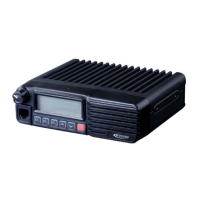PT8100 Service Manual
6
sent to Tx VCO.
Rx audio signal processing:
Voice signal from IC6 is divided into two parts. One branch
of the signal is routed to the low pass circuit consists of IC8,
where it is amplified and filtered (to remove the voice signal) to
obtain more purified CTCSS/DCS signal, which is then sent to
MCU for processing. The other branch of the signal goes to IC9.
After being amplified by IC9C (Q29 is the gain switching circuit
which is used to switch volume between wideband and
narrowband), the signal is divided into two branches again. One
branch is sent to the 2-tone (5-tone) shaping circuit consists of
Q8, Q52 and IC10, where it is shaped into better square wave
signal, and then is sent to MCU to judge the 2-tone (5-tone)
signal; the other branch passes through the high pass circuit
consists of IC9D to remove the sub-audio signal and passes
through the de-emphasis circuit consists of R173 and C245. Then
the de-emphasized signal is passed through the low pass circuit
consists of IC9A and IC9B and the high pass circuit consists of
Q26. After that, the resulting signal goes to the volume switch
where the signal volume will be adjusted. After being amplified
in IC7, the signal will be output to drive the speaker.
Impedance of the speaker: 16
Note:
* None of the terminals of the speaker should be grounded.
* The emergency alarm sound has no volume limit.
4.6 Power Supply:
The radio uses 13.8V battery, and the Tx power amplification
circuit (IC1) and Rx audio power amplifier (IC7) directly adopt
the battery for power supply.
IC17: 3V, LDO, micropower regulator, which supplies power for
MCU, DTMF decoding unit etc.
IC16: 8V, LDO, micropower regulator.
Q38: 8T switch, which is controlled by MCU.
8T: Supplies power for front end of transmitter.
Q40: 8R switch, which is controlled by MCU.
8R: Supplies power for RF amplifier and mixer of the receiver.
4.7 MCU Unit
MCU unit controls the operation of each unit of the radio so
that all functions can be realized.
Communicate with external PC.
Access the status data of the radio.
Control the PLL to generate Rx and Tx local oscillator
frequencies.
Obtain status parameters of the working channel.
Control status of LED indicator.
Control power supply for each unit.
Check the actions of each functional key.
Generate CTCSS signal.
Generate DCS signal.
Generate power control signal.
Perform CTCSS decoding.
Perform DCS decoding.
Perform 2Tone (5Tone) decoding.
Test and control the squelch.
Control content of voice alert.
4.8 Memory (E
2
PROM, AT24C512)
The memory is stored with channel data, CTCSS/DCS data,
other data for function setting, and parameter adjusting data.
CTCSS/DCS signal encoding and decoding:
CTCSS/DCS signal (output from pin97, PWM wave)
generated by MCU is sent to TCXO for modulation; and the
CTCSS/DCS signal (output from pin98, PWM wave) is sent to
VCO modulation.
CTCSS/DCS signal from the receiver is sent to MCU for
decoding. MCU checks if the CTCSS/DCS signal in the receiving
signal matches the preset value of the radio, and determines
whether to open the speaker or not.
CTCSS
CTCSS (Continuous Tone Control Squelch System) is a
squelch control system which is modulated on carrier and is
guided by a continuous sub-audio signal. If CTCSS is set, the
communication between the transmitting and receiving radios can
be realized only when the two radios have set the same CTCSS
frequency. In doing this, disturbance from other signals can be
avoided.
PT8100 has 39 groups of standard CTCSS frequencies for
your selection. See Table 4.1.
CTCSS signal (PWM wave) is generated by MCU, and is
passed through low pass filter consists of RC to remove the high
frequency components (above 300Hz). Then the resulting signal
is routed to VCO for modulation.
Table 4.1 CTCSS Frequencies
No. Frequency
[Hz]
No. Frequency
[Hz]
No. Frequency
[Hz]
No. Frequency
[Hz]
1 67.0 11 94.8 21 131.8 31 186.2
2 69.3 12 97.4 22 136.5 32 192.8
3 71.9 13 100.0 23 141.3 33 203.5

